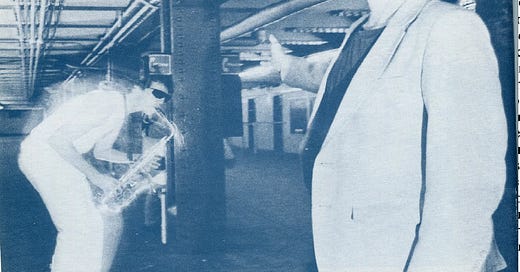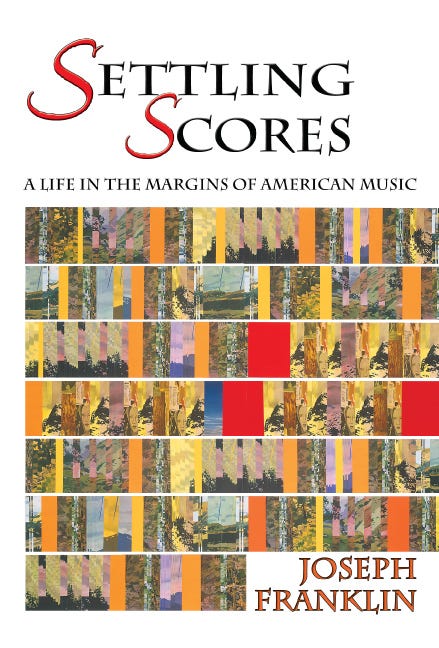(Oct 29) NMA Philadelphia 1987: installations and other sound creating devices

As with the other festivals, at New Music America 1987 in Philadelphia, the visual arts got a bit of short shrift when it came to media coverage - well, maybe not Alvin Curran but that was a hard one to avoid! But these traces of great works remain…
Our attempts to find the signal - Stuart Boesalager, Mary Jane Leach, Phill Niblock and I and I think a couple of others… in other words a rare recording of wild composers in the bush.
Relâche plays Bob Goldberg’s Music for Subways October 8, 1987
Part 1
Part 2
Part 3
Since this original post, Bob has come out with a “studio” recorded version of Music for Subways from 1999 in Brooklyn; he also notes that there was a released cassette for the original Ban Noise performance that Joseph Franklin alludes to in his Relâche Chronicles episode on the NMA installations of Philadelphia, and that’s been put on my Holy Grail of NMA Recordings list!
I’ve since taken that podcast and transcribed it, which you can find here:
Found this about Annson Kenney on y2b…
A 40 year retrospective of Christopher Janney’s works posted in 2021:
Joseph Franklin, on Patrick Zentz, from his memoir Settling Scores
The large guys plying me with whiskey were members of installation artist Patrick Zentz' entourage, Montana ranchers a long way from the desolation and sub-zero temperatures of the High Plains, taking full advantage of Philadelphia and the festival's nightlife.
Pat Zentz is an extraordinary artist and great guy, someone I got to know well during the three years I lived in Montana in the late 1990s. His friends were good guys as well but a bit out-of-control during their Philadelphia visit.
Take the evening I was working with David-Michael Kenney at the Painted Bride Art Center preparing for a concert and he handed the phone to me - one of his production guys was on the other end, agitated. "Hey, Joseph, we might have some trouble over here," Bobby said, the "over here" being the Port of History Theatre.
"What kind of trouble?" I asked.
"Well, some guys claim to have a festival pass but forgot them and want to get into the theatre anyway. What shall I do?" he asked.
"Who are they?" I asked.
"Don't know. They're not from around here, I think they're from one of those rectangular states out there."
I laughed. "Oh yeah, the guys from Montana. Let me talk to them."
It seems they had found a happy hour in some bar nearby and were feeling pretty good about things, not used to being told they can't go someplace, pass or no pass. I asked them to settle down and listen to the music. They did and there were no problems. The "rectangular state" reference made its way around the festival, much to everyone's amusement.
...
237
Crank is the creation of Patrick Zentz. Like many of his large scale works Crank is a mechanical structure designed to translate environmental forces like, for example, the changes in wind velocity or temperature levels on the surface of a structure. These natural conditions are collected, then through a variety of translation processes, activate a mechanical response in a structure or instrument located at a distance from the environmental source. Many of Patrick's works are the result of his having grown up in eastern Montana, living and working on a ranch where weather conditions are extreme and fluctuate dramatically. Patrick has created works and installed them in creeks or in the middle of a desolate field where wind, water and sunlight are translated into mechanical action, Crank is similarly designed except for a critical difference: it is meant to be installed in an urban environment.
The six bass drums - all hand made from luminous pinewood - are attached by wooden arms to a large wood and steel crank that moves a series of pulleys to activate a piano hammer that is attached to the end of the wood arm and fixed just in front of the bass drum. An electric motor turns the crank when activated by a series of photoelectric cells located at the base of the crank.
As traffic flows by disturbing or breaking the photoelectric beam solenoid switches are triggered setting the piano hammers in motion and striking the drums. The heavier the traffic flow the more frequent the beating of the drums. So, during the "march of the secretaries," Crank is cranking out some interesting rhythmic patterns. At other times during the day when the traffic flow is less, Crank stands alone in the middle of the brightly-lit atrium, in silent anticipation, waiting to sing once again.
Crank was commissioned by the Washington Project for the Arts in Washington, D.C. and installed there for a period of time. I first saw it at the Yellow Springs Institute where it was on display for two weeks while Patrick and his long-time friend and collaborator Dennis Voss were in residence. At that time they were both doing performance works based on their shared Montana experiences. Often these performances were part of their installations. In this case through Crank worked as a solo act in one of the gallery spaces at Yellow Springs. After meeting Patrick and Dennis, Arthur Sabitini and I immediately decided to invite Patrick on the festival. But there were logistical complications.
Their residency at Yellow Springs was during July. New Music America '87 was in October. So Crank had to be stored someplace in the area for two-and-a-half months since the cost of shipping the thing back-and-forth to
238
Montana and Philadelphia was prohibitive. And Crank is very heavy. Fortunately one of Patrick's Montana friends was originally from the Norristown, Pennsylvania area and had relatives living on a farm nearby so he arranged for us to store Crank in their empty barn until we were able to install it at the Curtis Center in late September.
Although it took a considerable effort to move Crank from its storage facility to downtown Philadelphia, it was well worth it. Along with the other sonic installations on the festival program, Crank was a popular destination for the curious and playful, in addition to the apprehensive secretaries.
I'm not certain how active Crank has been since the festival. I've often wondered if any of the secretaries who drove Crank crazy during their early morning and late afternoon strolls through the Curtis Center in 1987 remember his songs, especially if they've walked by any other installations that Pat Zentz has installed at airports, convention centers and other public venues throughout the United States. I do know that Pat Zentz continues making large interactive works even more striking than Crank. Because of his success he no longer works his ranch in Laurel, Montana, instead, devoting all his time to creating art works.
===============











